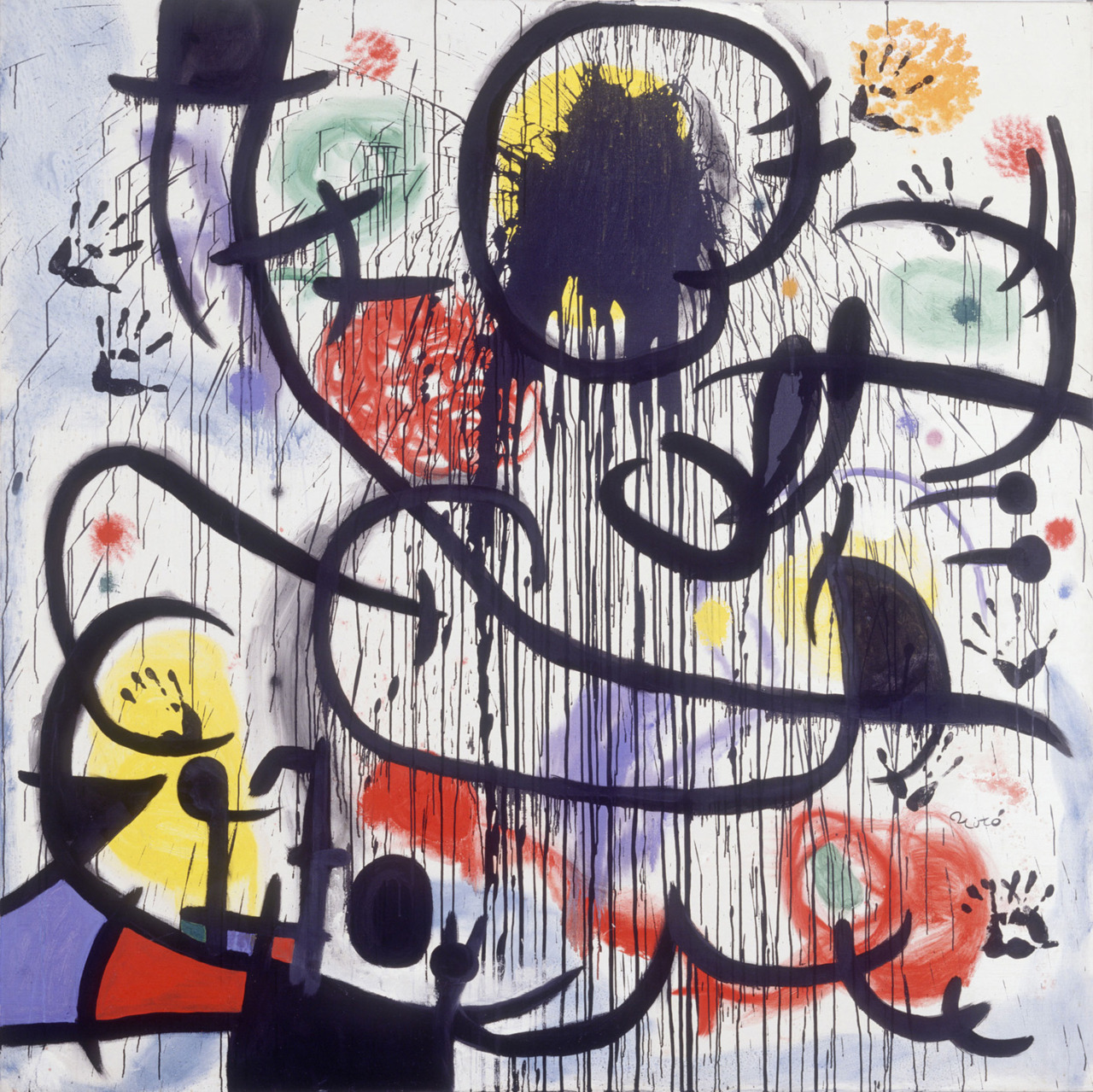Joan Miró was certainly never an explicitly political artist. Yet neither was he a pure formalist, an artist dealing exclusively with colors or forms, turning a blind eye to social developments. His country’s history, the movement for Catalan independence, the Civil War and the subsequent Franco dictatorship, not to mention World War II, all molded him and influenced his work. Miró never made any secret of the fact that he was against the dictatorship, that he was a man of freedom and liberalism, even if he was not among those who positioned themselves at the front line of confrontation.
When the Spanish Civil War broke out in 1936, the artist was at Mont-roig del Camp. His family moved out of Barcelona to the province of Tarragona; one of the artist’s key early works shows the farm they ran there painted in a surreal style. Miró had already been commuting between Paris and Mont-roig for some time. During that period he was experimenting with unusual materials, creating a series of pictures using wood-fiber panels. In October 1936 he fled to France, before confrontations began between the right-leaning putschists surrounding General Francisco Franco and the elected Popular Front government. Even from there he supported the Republican fighters through his art. “Aidez l’Espagne” – Help Spain – is written above a print he produced in 1937. The image shows a figure in black, white, red and yellow tones, raising his fist aggressively.
The defense of freedom
Miró was also involved in the design of the Spanish Pavilion for the World Exhibition, which took place in the same year in Paris. The exhibition space for the Spaniards became an expression of modern artists’ solidarity with Republican Spain. Miró’s mural – the first he had produced in a public space – was called “The Reaper”. It showed a distorted face and an unraveled figure and can be seen as a representation of suffering. Alongside Miró, Picasso also worked in Paris on his world-famous painting “Guernica”, which expressed the horror of the war more vividly than virtually any other image. Also for the World Exhibition, Alexander Calder created his famous Mercury Fountain – a copy of the sculpture can be found in the Fundació Joan Miró in Barcelona. “Freedom has meaning for me and I will defend it at any cost”, Miró declared in an interview at the time.
%20by%20Joan%20Miro.jpg)
Joan Miró, Aidez L'Espagne, 1937, Image via abs-art.com
The artist remained in France whilst the Civil War in his homeland gradually drew to a close. In April 1939 the Nationalists’ victory was sealed. Spain stood on the verge of a dictatorship that would last for almost 40 years. In August 1939 Miró left Paris with his wife Pilar and his daughter and moved to Varengeville in Normandy a few days before the outbreak of World War II. George Braque lived in the neighborhood. It was in Varengeville that Miró began working on a new series of gouaches, the “Constellations”. In these he tackled the subject of nature, creating playful images of stars and distributing circles, figures, stars and points across the surfaces of the paintings. For the artist, these images were an escape, a way to counteract the horror of the time in which they were produced, of fascism, war and intolerance. “I felt a deep desire to escape”, is how Miró described his situation in hindsight. “I closed myself within myself purposely. The night, music and the stars all began to play a major role when it came to motifs for my paintings.”
The last train
The Miró family only stayed in Varengeville for a short time; the advance of the German troops into France forced them to flee again. On May 20, 1940 Miró managed to secure tickets for himself and his family on the last train leaving for Paris at the time. From the French capital they left for Spain, taking refuge in Mallorca with Pilar’s family. It was in Palma de Mallorca that Miró later set up his large workshop, which was designed by one of his best friends, the architect Lluís Sert.

Joan Miró, Composition (Petit Univers), 1933, Image via fondationbeyeler.ch
Social events and political themes continued to find their way into Miró’s work. With the outbreak of the student protests in Paris in May 1968 the artist began a painting he intended as an homage to the movement. He continued working on “May 1968” right up until 1973, and the painting is now in the possession of the Miró Foundation in Barcelona. It is full of energy, full of color. Blots of color sit over curved forms; Miró was influenced in the work by the drip paintings of Jackson Pollock.
The path to democracy
In 1974 Miró painted the triptych “The Hope of a Condemned Man” as an indictment of the Franco regime. The monumental work commemorates the anarchist Salvador Puig Antich, whom Franco had executed that year. The bloody act was also a rebellion against impending change. The Franco regime was isolated, and there was rising pressure on the authoritarian system both from inside and out. In November 1975 the dictator died, leaving the way free for democracy, and the transition phase known as the “Transición” began. For Miró it was a new beginning, he was overjoyed to be able to experience this moment. “I’m heading in new directions”, he explained in 1978 at an exhibition opening. He was 85 years old.

Joan Miró, Mai 1968, Image via tumblr.austinkleon.com
WELL PREPARED FOR THE EXHIBITION
The free digitorial about JOAN MIRÓ
